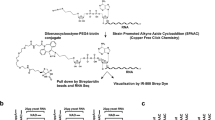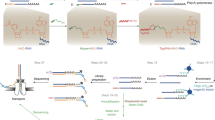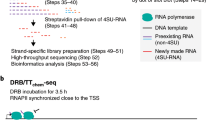Abstract
Chemical modifications of transcripts with a 5′ cap occur in all organisms and function in many aspects of RNA metabolism. To facilitate analysis of RNA caps, we developed a systems-level mass spectrometry-based technique, CapQuant, for accurate and sensitive quantification of the cap epitranscriptome. The protocol includes the addition of stable isotope-labeled cap nucleotides (CNs) to RNA, enzymatic hydrolysis of endogenous RNA to release CNs, and off-line enrichment of CNs by ion-pairing high-pressure liquid chromatography, followed by a 17 min chromatography-coupled tandem quadrupole mass spectrometry run for the identification and quantification of individual CNs. The total time required for the protocol can be up to 7 d. In this approach, 26 CNs can be quantified in eukaryotic poly(A)-tailed RNA, bacterial total RNA and viral RNA. This protocol can be modified to analyze other types of RNA and RNA from in vitro sources. CapQuant stands out from other methods in terms of superior specificity, sensitivity and accuracy, and it is not limited to individual caps nor does it require radiolabeling. Thanks to its unique capability of accurately and sensitively quantifying RNA caps on a systems level, CapQuant can reveal both the RNA cap landscape and the transcription start site distribution of capped RNA in a broad range of settings.
Key points
-
CapQuant involves the addition of stable isotope-labeled cap nucleotides (CNs) to RNA, enzymatic hydrolysis of endogenous RNA to release CNs, and off-line enrichment of CNs by ion-pairing high-pressure liquid chromatography, followed by chromatography-coupled tandem quadrupole mass spectrometry for the identification and quantification of individual CNs.
-
CapQuant solves problems associated with other cap analysis tools, which are limited to individual cap structures, are poorly quantitative, lack sensitivity, require radioactive labeling and lack chemical specificity. It achieves high coverage with absolute quantification over a broad dynamic range starting at attomole levels.
This is a preview of subscription content, access via your institution
Access options
Access Nature and 54 other Nature Portfolio journals
Get Nature+, our best-value online-access subscription
$29.99 / 30 days
cancel any time
Subscribe to this journal
Receive 12 print issues and online access
$259.00 per year
only $21.58 per issue
Buy this article
- Purchase on Springer Link
- Instant access to full article PDF
Prices may be subject to local taxes which are calculated during checkout








Similar content being viewed by others
Data availability
Part of the data and supporting data were published in Nucleic Acids Research13. Supporting data and raw data can be found in Supplementary Information and deposited in the Chorus Project public repository (Project ID: 1809), respectively.
References
Helm, M. & Alfonzo, J. D. Posttranscriptional RNA modifications: playing metabolic games in a cell’s chemical Legoland. Chem. Biol. 21, 174–185 (2014).
Ramanathan, A., Robb, G. B. & Chan, S. H. mRNA capping: biological functions and applications. Nucleic Acids Res. 44, 7511–7526 (2016).
Hyde, J. L. & Diamond, M. S. Innate immune restriction and antagonism of viral RNA lacking 2-O methylation. Virology 479–480, 66–74 (2015).
Kastern, W. H. & Berry, S. J. Non-methylated guanosine as 5′ terminus of capped messenger-rna from insect oocytes. Biochem. Biophys. Res. Commun. 71, 37–44 (1976).
Wei, C., Gershowitz, A. & Moss, B. N6, O2′-dimethyladenosine a novel methylated ribonucleoside next to the 5′ terminal of animal cell and virus mRNAs. Nature 257, 251–253 (1975).
HsuChen, C. C. & Dubin, D. T. Di-and trimethylated congeners of 7-methylguanine in Sindbis virus mRNA. Nature 264, 190–191 (1976).
Byszewska, M., Smietanski, M., Purta, E. & Bujnicki, J. M. RNA methyltransferases involved in 5′ cap biosynthesis. RNA Biol. 11, 1597–1607 (2014).
Bird, J. G. et al. The mechanism of RNA 5′ capping with NAD+, NADH and desphospho-CoA. Nature 535, 444–447 (2016).
Julius, C. & Yuzenkova, Y. Bacterial RNA polymerase caps RNA with various cofactors and cell wall precursors. Nucleic Acids Res. 45, 8282–8290 (2017).
Jaschke, A., Hofer, K., Nubel, G. & Frindert, J. Cap-like structures in bacterial RNA and epitranscriptomic modification. Curr. Opin. Microbiol. 30, 44–49 (2016).
Kiledjian, M. Eukaryotic RNA 5′-end NAD+ capping and DeNADding. Trends Cell Biol. 28, 454–464 (2018).
Yu, X. et al. Messenger RNA 5′ NAD+ capping is a dynamic regulatory epitranscriptome mark that is required for proper response to abscisic acid in arabidopsis. Dev. Cell 56, 125–140 e126 (2021).
Wang, J. et al. Quantifying the RNA cap epitranscriptome reveals novel caps in cellular and viral RNA. Nucleic Acids Res. 47, e130 (2019).
Abraham, G., Rhodes, D. P. & Banerjee, A. K. The 5′ terminal structure of the methylated mRNA synthesized in vitro by vesicular stomatitis virus. Cell 5, 51–58 (1975).
Mauer, J. et al. Reversible methylation of m(6)Am in the 5′ cap controls mRNA stability. Nature 541, 371–375 (2017).
Topisirovic, I., Svitkin, Y. V., Sonenberg, N. & Shatkin, A. J. Cap and cap-binding proteins in the control of gene expression. Wiley Interdiscip. Rev. RNA 2, 277–298 (2011).
Adams, N. M. et al. Comparison of three magnetic bead surface functionalities for RNA extraction and detection. ACS Appl. Mater. Interfaces 7, 6062–6069 (2015).
Furuichi, Y. Discovery of m7G-cap in eukaryotic mRNAs. Proc. Jpn Acad. Ser. B 91, 394–409 (2015).
Shatkin, A. J. Capping of eucaryotic mRNAs. Cell 9, 645–653 (1976).
Wei, C. M., Gershowitz, A. & Moss, B. 5′-Terminal and internal methylated nucleotide sequences in HeLa cell mRNA. Biochemistry 15, 397–401 (1976).
Cleaver, J. E. & Burki, H. J. Letter: biological damage from intranuclear carbon-14 decays: DNA single-strand breaks and repair in mammalian cells. Int. J. Radiat. Biol. Relat. Stud. Phys. Chem. Med. 26, 399–403 (1974).
Minor, R. R. Cytotoxic effects of low levels of 3H-, 14C-, and 35S-labeled amino acids. J. Biol. Chem. 257, 10400–10413 (1982).
Abdelhamid, R. F. et al. Multiplicity of 5′ cap structures present on short RNAs. PLoS ONE 9, e102895 (2014).
Akichika, S. et al. Cap-specific terminal N6-methylation of RNA by an RNA polymerase II-associated methyltransferase. Science 363, eaav0080 (2019).
Beverly, M., Dell, A., Parmar, P. & Houghton, L. Label-free analysis of mRNA capping efficiency using RNase H probes and LC–MS. Anal. Bioanal. Chem. 408, 5021–5030 (2016).
Chen, Y. G., Kowtoniuk, W. E., Agarwal, I., Shen, Y. & Liu, D. R. LC/MS analysis of cellular RNA reveals NAD-linked RNA. Nat. Chem. Biol. 5, 879–881 (2009).
Ohira, T. & Suzuki, T. Precursors of tRNAs are stabilized by methylguanosine cap structures. Nat. Chem. Biol. 12, 648–655 (2016).
Peyrane, F. et al. High-yield production of short GpppA- and (7Me)GpppA-capped RNAs and HPLC-monitoring of methyltransfer reactions at the guanine-N7 and adenosine-2′O positions. Nucleic Acids Res. 35, e26 (2007).
Cahova, H., Winz, M.-L., Höfer, K., Nübel, G. & Jäschke, A. NAD captureSeq indicates NAD as a bacterial cap for a subset of regulatory RNAs. Nature 519, 374–377 (2015).
Shao, X. et al. NAD tagSeq for transcriptome-wide identification and characterization of NAD+-capped RNAs. Nat. Protoc. 15, 2813–2836 (2020).
Hu, H. et al. SPAAC-NAD-seq, a sensitive and accurate method to profile NAD(+)-capped transcripts. Proc. Natl Acad. Sci. USA https://doi.org/10.1073/pnas.2025595118 (2021).
Galloway, A. et al. CAP-MAP: cap analysis protocol with minimal analyte processing, a rapid and sensitive approach to analysing mRNA cap structures. Open Biol. 10, 190306 (2020).
Gao, Y., Bu, J., Peng, Z. & Yang, B. Radical reactions in the gas phase: recent development and application in biomolecules. J. Spectrosc. https://doi.org/10.1155/2014/570863 (2014).
Hu, J., Lei, W., Wang, J., Chen, H. Y. & Xu, J. J. Regioselective 5′-position phosphorylation of ribose and ribonucleosides: phosphate transfer in the activated pyrophosphate complex in the gas phase. Chem. Commun. 55, 310–313 (2019).
Strzelecka, D., Chmielinski, S., Bednarek, S., Jemielity, J. & Kowalska, J. Analysis of mononucleotides by tandem mass spectrometry: investigation of fragmentation pathways for phosphate- and ribose-modified nucleotide analogues. Sci. Rep. 7, 8931 (2017).
Grudzien-Nogalska, E., Bird, J. G., Nickels, B. E. & Kiledjian, M. “NAD-capQ” detection and quantitation of NAD caps. RNA 24, 1418–1425 (2018).
Moya-Ramirez, I., Bouton, C., Kontoravdi, C. & Polizzi, K. High resolution biosensor to test the capping level and integrity of mRNAs. Nucleic Acids Res. 48, e129 (2020).
Liu, S. & Wang, Y. Mass spectrometry for the assessment of the occurrence and biological consequences of DNA adducts. Chem. Soc. Rev. 44, 7829–7854 (2015).
Villalta, P. W. & Balbo, S. The future of DNA adductomic analysis. Int. J. Mol. Sci. 18, 1870 (2017).
Dominissini, D. et al. The dynamic N1-methyladenosine methylome in eukaryotic messenger RNA. Nature 530, 441–446 (2016).
Li, X. et al. Transcriptome-wide mapping reveals reversible and dynamic N1-methyladenosine methylome. Nat. Chem. Biol. 12, 311–316 (2016).
Safra, M. et al. The m1A landscape on cytosolic and mitochondrial mRNA at single-base resolution. Nature 551, 251–255 (2017).
Dong, H. et al. 2′-O methylation of internal adenosine by flavivirus NS5 methyltransferase. PLoS Pathog. 8, e1002642 (2012).
Murata, M. et al. in Transcription Factor Regulatory Networks: Methods and Protocols. (eds E. Miyamoto-Sato et al.) 67–85 (Springer, 2014).
Kanamori-Katayama, M. et al. Unamplified cap analysis of gene expression on a single-molecule sequencer. Genome Res. 21, 1150–1159 (2011).
Lu, Z. & Lin, Z. Pervasive and dynamic transcription initiation in Saccharomyces cerevisiae. Genome Res. 29, 1198–1210 (2019).
Lizio, M. et al. Gateways to the FANTOM5 promoter level mammalian expression atlas. Genome Biol. 16, 22 (2015).
Lizio, M. et al. Update of the FANTOM web resource: high resolution transcriptome of diverse cell types in mammals. Nucleic Acids Res. 45, D737–D743 (2017).
Afgan, E. et al. The Galaxy platform for accessible, reproducible and collaborative biomedical analyses: 2018 update. Nucleic Acids Res. 46, W537–W544 (2018).
Quinlan, A. R. & Hall, I. M. BEDTools: a flexible suite of utilities for comparing genomic features. Bioinformatics 26, 841–842 (2010).
Mauer, J. et al. Reversible methylation of m6Am in the 5′ cap controls mRNA stability. Nature 541, 371–375 (2017).
Acknowledgements
We thank G. Walker and J. Chen from the Massachusetts Institute of Technology for generously sharing S. cerevisiae W1588-4C and human CCRF-SB cells, respectively. Financial support was provided by grants from the National Institutes of Health (ES022858 to P.C.D. and MH121072 and HG011563 to S.R.J.), the Singapore-MIT Alliance for Research and Technology with a grant from the National Research Foundation of Singapore, the National Natural Science Foundation of China (31960140 to J.W.), the Natural Science Foundation of Inner Mongolia Autonomous Region (2021JQ03 to J.W.), the Central Guiding Fund for Local Science and Technology Development (2020ZY0100 to J.W.), the Independent Project of State Key Laboratory of Reproductive Regulation and Breeding of Grassland Livestock (SKL-IT-201830 to J.W.), the ‘Grassland Talents’ Program of Inner Mongolia Autonomous Region (to J.W.), the High-Level Talents Research Support Program of Inner Mongolia Autonomous Region (to J.W.), the ‘Steed Plan’ High-Level Talents Program of Inner Mongolia University (to J.W.), the Science and Technology Leading Talent Team Program of Inner Mongolia Autonomous Region (2022LJRC0009 to W. Hu from Inner Mongolia University and Fudan University), the Science and Technology Major Special Project of Inner Mongolia Autonomous Region (2020ZD0008 to Prof. Wei Hu from Inner Mongolia University and Fudan University) and the Nanyang Presidential Graduate Scholarship and the LKCMedicine Dean’s Postdoctoral Fellowship (to B.L.A.C.).
Author information
Authors and Affiliations
Contributions
J.W. and P.C.D. conceived of CapQuant and designed the experiments. J.W., B.L.A.C. and P.C.D. developed the method, and wrote the first draft of the manuscript. J.W., B.L.A.C. and P.C.D. performed the cap analysis experiments and data analyses. Yong L. and T.K.L. performed yeast culturing. P.-Y.S. and H.D. were responsible for virus culturing, viral RNA isolation and synthesis of the GpppAm- and m7GpppAm-capped RNA oligos. S.R.J. provided the Gpppm6Am- and m7Gpppm6Am-capped RNA oligos and contributed insights and analysis. J.W. performed human and bacteria cell culturing, isolation of cell and tissue RNA, SEC purification of viral RNA, QC RNA quality experiments and data analyses, syntheses of all other (m7)GpppN(m)-capped RNA oligos and all 15N5-(m7)GpppN(m)-capped RNA oligos, purification of the unlabeled and labeled (m7)GpppN(m) CN standards, and determination of the IP of all labeled CN standards. D.L. provided the dengue NS5 methyltransferase that was used in the synthesis of the 15N5-Gpppm6Am-capped RNA oligo and contributed insights and analysis. X.-Y.F. and L.X. were responsible for the mouse experiments. B.L.A.C., P.C.D. and J. W. performed the cross-validation experiments and data analyses with insights from Z.L. Y.L. performed data analyses, prepared graphics, and edited the manuscript. All authors participated in the writing of the manuscript.
Corresponding authors
Ethics declarations
Competing interests
J.W. is founder, executive director and general manager, and owns equity, in 中康鸿信. S.R.J. is cofounder of and advisor to, and owns equity in, Gotham Therapeutics. P.C.D. is cofounder and advisor to, and owns equity in, Hovana Inc., Proteomax Pte. Ltd., and Codomax Inc.
Peer review
Peer review information
Nature Protocols thanks Balasubrahmanyam Addepalli, Yinsheng Wang and the other, anonymous, reviewer(s) for their contribution to the peer review of this work.
Additional information
Publisher’s note Springer Nature remains neutral with regard to jurisdictional claims in published maps and institutional affiliations.
Related links
Key reference using this protocol
Wang, J. et al. Nucleic Acids Res. 47, e130 (2019): https://doi.org/10.1093/nar/gkz751
Supplementary information
Supplementary Information
Supplementary Methods and Figs. 1–5.
Rights and permissions
Springer Nature or its licensor (e.g. a society or other partner) holds exclusive rights to this article under a publishing agreement with the author(s) or other rightsholder(s); author self-archiving of the accepted manuscript version of this article is solely governed by the terms of such publishing agreement and applicable law.
About this article
Cite this article
Wang, J., Chew, B.L.A., Lai, Y. et al. A systems-level mass spectrometry-based technique for accurate and sensitive quantification of the RNA cap epitranscriptome. Nat Protoc 18, 2671–2698 (2023). https://doi.org/10.1038/s41596-023-00857-0
Received:
Accepted:
Published:
Issue Date:
DOI: https://doi.org/10.1038/s41596-023-00857-0
Comments
By submitting a comment you agree to abide by our Terms and Community Guidelines. If you find something abusive or that does not comply with our terms or guidelines please flag it as inappropriate.



